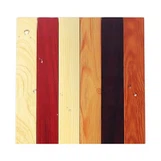As a supplier of 3003 aluminum sheets, I often encounter questions from customers regarding various properties of this material. One of the frequently asked questions is about the emissivity of 3003 aluminum sheet. In this blog post, I'll delve into what emissivity is, the emissivity of 3003 aluminum sheet, and why it matters in different applications.
Understanding Emissivity
Emissivity is a measure of how efficiently a material emits thermal radiation compared to a perfect emitter, known as a blackbody. A blackbody has an emissivity of 1.0, meaning it emits the maximum amount of radiation possible at a given temperature. Real - world materials have emissivities between 0 and 1. The emissivity of a material depends on several factors, including its surface finish, temperature, and the wavelength of the radiation being considered.
Emissivity of 3003 Aluminum Sheet
The emissivity of 3003 aluminum sheet can vary widely depending on its surface condition. A clean, polished 3003 aluminum sheet has a relatively low emissivity, typically in the range of 0.03 - 0.1. This low emissivity is due to the highly reflective nature of the polished surface, which reflects a large portion of the incident radiation rather than absorbing and re - emitting it.
On the other hand, if the 3003 aluminum sheet has a rough or oxidized surface, its emissivity can increase significantly. Oxidation forms a layer on the surface of the aluminum, which is less reflective and more absorptive of thermal radiation. An oxidized 3003 aluminum sheet can have an emissivity ranging from 0.2 to 0.4 or even higher, depending on the degree of oxidation.
It's important to note that emissivity also varies with temperature. As the temperature of the 3003 aluminum sheet increases, the emissivity may change. Generally, for most metals, including 3003 aluminum, the emissivity increases slightly with increasing temperature, but the change is relatively small within normal operating temperatures.
Factors Affecting the Emissivity of 3003 Aluminum Sheet
Surface Finish
As mentioned earlier, the surface finish has a major impact on emissivity. A smooth, polished surface will have a lower emissivity compared to a rough or textured surface. For example, a mill - finish 3003 aluminum sheet, which has a relatively smooth but not highly polished surface, may have an emissivity around 0.05 - 0.1. If the sheet is sand - blasted or has a brushed finish, the increased surface roughness will cause more scattering of the incident radiation, leading to a higher emissivity.
Oxidation
Oxidation is another crucial factor. Aluminum readily forms a thin oxide layer when exposed to air. This oxide layer changes the optical and thermal properties of the surface. The initial oxidation of a 3003 aluminum sheet may cause a small increase in emissivity. However, if the oxidation is allowed to progress over time, especially in a humid or corrosive environment, the emissivity can increase significantly.
Coatings
Applying coatings to the 3003 aluminum sheet can also alter its emissivity. For instance, a paint coating on the aluminum sheet will increase the emissivity. Different types of paints have different emissivity values, and the overall emissivity of the coated sheet will depend on the thickness and composition of the paint layer. A high - emissivity paint can increase the emissivity of the 3003 aluminum sheet to values close to 0.9, making it a more efficient emitter of thermal radiation.
Importance of Emissivity in Applications
Heat Transfer
Emissivity plays a vital role in heat transfer applications. In heat exchangers, for example, a higher emissivity can enhance the radiative heat transfer between the 3003 aluminum sheet and its surroundings. This can improve the efficiency of the heat exchanger, allowing for better cooling or heating performance.
On the other hand, in applications where heat retention is desired, such as in some industrial ovens or thermal insulation systems, a low - emissivity 3003 aluminum sheet may be preferred. The low emissivity reduces the amount of heat radiated away from the material, helping to maintain a stable temperature inside the system.
Thermal Imaging
In thermal imaging applications, the emissivity of the 3003 aluminum sheet affects the accuracy of temperature measurements. Thermal imaging cameras detect the infrared radiation emitted by objects to determine their temperature. If the emissivity value used in the camera's calibration is incorrect, the measured temperature will be inaccurate. Therefore, knowing the correct emissivity of the 3003 aluminum sheet is crucial for obtaining reliable temperature readings.
Our 3003 Aluminum Sheet Products
We offer a wide range of 3003 aluminum sheet products to meet different customer needs. Our 3003 Pure Aluminum Alloy Plate is known for its high purity and excellent formability. It can be used in various applications, from automotive parts to electronic enclosures.
The 3003 H14 Aluminum Sheet has a specific temper that provides good strength and workability. It is suitable for applications where moderate strength and formability are required, such as in the manufacturing of furniture and signage.


Our Astm B209 Alloy 3003 H14 meets the strict standards of ASTM B209, ensuring high - quality and consistent performance. This product is widely used in industries that require reliable and standardized aluminum materials.
Contact Us for Procurement
If you are interested in our 3003 aluminum sheet products or have any questions about emissivity or other properties, please feel free to contact us. We have a team of experts who can provide you with detailed information and assist you in making the right choice for your specific application. Whether you need a small quantity for a prototype or a large - scale order for an industrial project, we are here to serve you.
References
- Incropera, F. P., & DeWitt, D. P. (2002). Fundamentals of Heat and Mass Transfer. John Wiley & Sons.
- Holman, J. P. (2010). Heat Transfer. McGraw - Hill.
- Aluminum Association. (2023). Aluminum Standards and Data.




